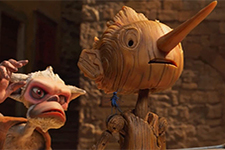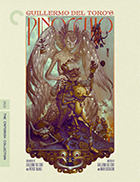Guillermo del Toro's Pinocchio (4K UHD)
|  It isn’t too often that a filmmaker’s name is included as part of a film’s official title. Oftentimes, there is a simple, legal necessity, as in the case of Lee Daniels’ The Butler (2013) and, most recently, Guy Ritchie’s The Covenant (2023), where the inclusion of the director’s name is needed to differentiate the film from another with legitimate claim to the same title (of course, they could always just change the title entirely). And then there are the cases of artistic hubris, such as Federico Fellini’s brief, late-career tendency to append his last name to the front of his films: Fellini Satyricon (1969), Fellini’s Casanova (1974). And, although it was never officially part of the title, the sheer size of Michael Cimino’s possessive moniker above the title of his notorious 1980 box-office disaster Heaven’s Gate on all the advertising would seem to suggest that they are one in the same. Which brings us to the title of Guillermo del Toro’s Pinocchio, a beautifully rendered, politically attuned, and emotionally stirring stop-motion-animated take on Carlo Collodi’s 1883 novel. The justification of including del Toro’s name in the title likely falls somewhere between the practical and the auteuristic. There are dozens of screen adaptations of Pinocchio out there—from Giulio Antamoro’s 1911 silent film (the first on record), to Walt Disney’s masterful 1940 animated musical version (the most well-known), to Roberto Benigni’s misguided 2002 live-action film. Pinocchio has been portrayed in films and on television in countries all around the world by children, teenagers, and adults; he has been animated by hand, by stop-motion figures and clay, and by computers. Last year, Robert Zemeckis returned to the world of CGI motion capture with Tom Hanks (star of Zemeckis’s first foray into digital filmmaking, 2004’s The Polar Express) to remake the Disney version, and given how badly it was received both critically and commercially, it makes sense that del Toro would want to differentiate his film as much as possible (this is not another Disney take). And, of course, given the manner in which Collodi’s tale has been reimagined through del Toro’s unique artistry and thematic preoccupations, the film arguably earns that possessive in the title, even though del Toro shares screenwriting credit with Patrick McHale (Adventure Time) and Matthew Robbins (Mimic, Crimson Peak) and co-directed the film with Mark Gustafson (who was the animation director on Wes Anderson’s Fantastic Mr. Fox). While much of the film stays true to the spirit of Collodi’s episodic novel, some substantial changes have been made, starting with the setting. Although it still takes place in Italy, del Toro and McHale (working from a story concocted by del Toro and Robbins) move the time frame up to the early 20th century, which allows them to unfurl Pinocchio’s tale of woe within the violent context of World War I, the rise of Italian fascism under Mussolini (who makes a humorous cameo), and World War II. Rather than being a childless man, the puppet-maker Geppetto (David Bradley) is a grieving father whose son, Carlo (Gregory Mann), was killed in a bombing during the First World War. Thus, Pinocchio is not carved out of a loving desire to have a child, but rather in a drunken, grievous rage at the injustice of it all. The manner in which del Toro and Gustafson stage Geppetto’s creation of Pinocchio is reminiscent of the operatic violence that Kenneth Branagh captured so well in the creation scene in Mary Shelley’s Frankenstein (1994), a film that is all too often criticized for its visual and tonal flamboyance. Geppetto literally hacks Pinocchio into existence, slamming his parts together and leaving him unfinished, a rough approximation of a puppet boy who comes to life through the magical intervention of a blue wood sprite (Tilda Swinton), who then assigns his care to Sebastian J. Cricket (Ewan McGregor), a worldly insect who had made his home inside the tree that Geppetto chops down to make Pinocchio and who narrates the story with a droll wit. Geppetto’s terrified response to Pinocchio’s coming to life is reminiscent of Frankenstein’s to his creature, as is the ambivalence he initially feels toward his supernatural creation, although he later comes to love and appreciate the wooden boy, especially when Pinocchio (also voiced by Mann) essentially sacrifices himself for Geppetto’s protection. As in virtually all tellings of the Pinocchio story, the wooden puppet is tempted and fails to resist temptation, succumbing to the lures of worldliness and fame, especially as embodied in the travelling carnival of Count Volpe (Christoph Waltz), whose horn-like hair and devilish sway tell you all you need to know about how dangerous he is. An artiste-gone-bad, Volpe is a viper in waiting who snatches up Pinocchio and rightly recognizes the financial benefit of having a wooden puppet who speaks, sings, and dances as his main attraction, much to the chagrin of Spazzatura (Cate Blanchett), his righthand monkey who first resents Pinocchio’s presence, but then recognizes him as a fellow victim of manipulation and abuse. This being Guillermo del Toro’s Pinocchio, there is a great deal of horrific human behavior on display, but also more than enough decency, kindness, and forgiveness to balance out the trauma. Outside of the Machiavellian Volpe, the film’s most nefarious villain is Podesto (Ron Perlman, whose work with del Toro dates back to his directorial debut, 1992’s Cronos), a seething fascist officer who is attempting to force his son, Candlewick (Finn Wolfhard), into the same mold. Podesto is particularly interested in Pinocchio when he discovers that Pinocchio can’t die. Well, he can die, but for him death is only temporary. Upon dying, Pinocchio is sent to a nebulous afterlife populated by black rabbits (all voiced by Tim Blake Nelson) and Death itself (Tilda Swinton, again), who informs Pinocchio that he will always return to Earth, but each time he dies he has to spend a bit longer in the afterlife. The film’s visual look is heavily indebted to Gris Grimly’s illustrations to a 2002 edition of Collodi’s novel, which del Toro and Gustafson bring to life with a deft mixture of loving craftsmanship and twisted wit (the vast majority of the visuals were created with old-fashioned stop-motion animation employing armatures and elaborate sets, although the world and some of the action is clearly elaborated with computer-generated effects). This Pinocchio doesn’t look anything like what you’ve probably seen before, and that is one of its greatest attributes. The hand-crafted characters and sets are immersive in their detail, providing a sense of tactile reality that belies the clear artifice (the expressionist cinematography is by Frank Passingham, a veteran of Aardman Studios who so lovingly recreated the look of World War II prison camp films in 2000’s Chicken Run). The filmmakers make the old material feel new, but also true to the source and, more importantly, true to the emotions they are engaging. Pinocchio himself a complicated mixture of naivete, mischievousness, and absurdity. He enters life with a song that revolves entirely around his fascination with objects, most of which he breaks; he asks many questions, some of them embarrassing, some of them poignant, which marks him as a child open to both wonder and temptation. As the film progresses, Pinocchio grows a genuine conscience, which sets him apart from all the evils of the world around him. Del Toro isn’t after moral simplicity, but he nevertheless relies heavily on a moral structure that bends, but never breaks. There is a deep sadness to the film, hinged primarily on the reality that the violent world into which Pinocchio is brought to life will continue with its violence, regardless of his own moral improvement. Del Toro’s horror and fantasy films such as The Devil’s Backbone (2003), Pan’s Labyrinth (2006) and the multi-Oscar-winning The Shape of Water (2018) have always found sympathy with what we conventionally call the monster, and the same is true here. Pinocchio himself is a kind of monster, at least at first, but we quickly learn that his faults and failures are nothing compared to the horrors of fascism, a theme that del Toro has returned to again and again. That possessive in the title fits.
Copyright © 2024 James Kendrick Thoughts? E-mail James Kendrick All images copyright © The Criterion Collection / Netflix | |||||||||||||||||||||||||||||
Overall Rating: 


 (3.5)
(3.5)


